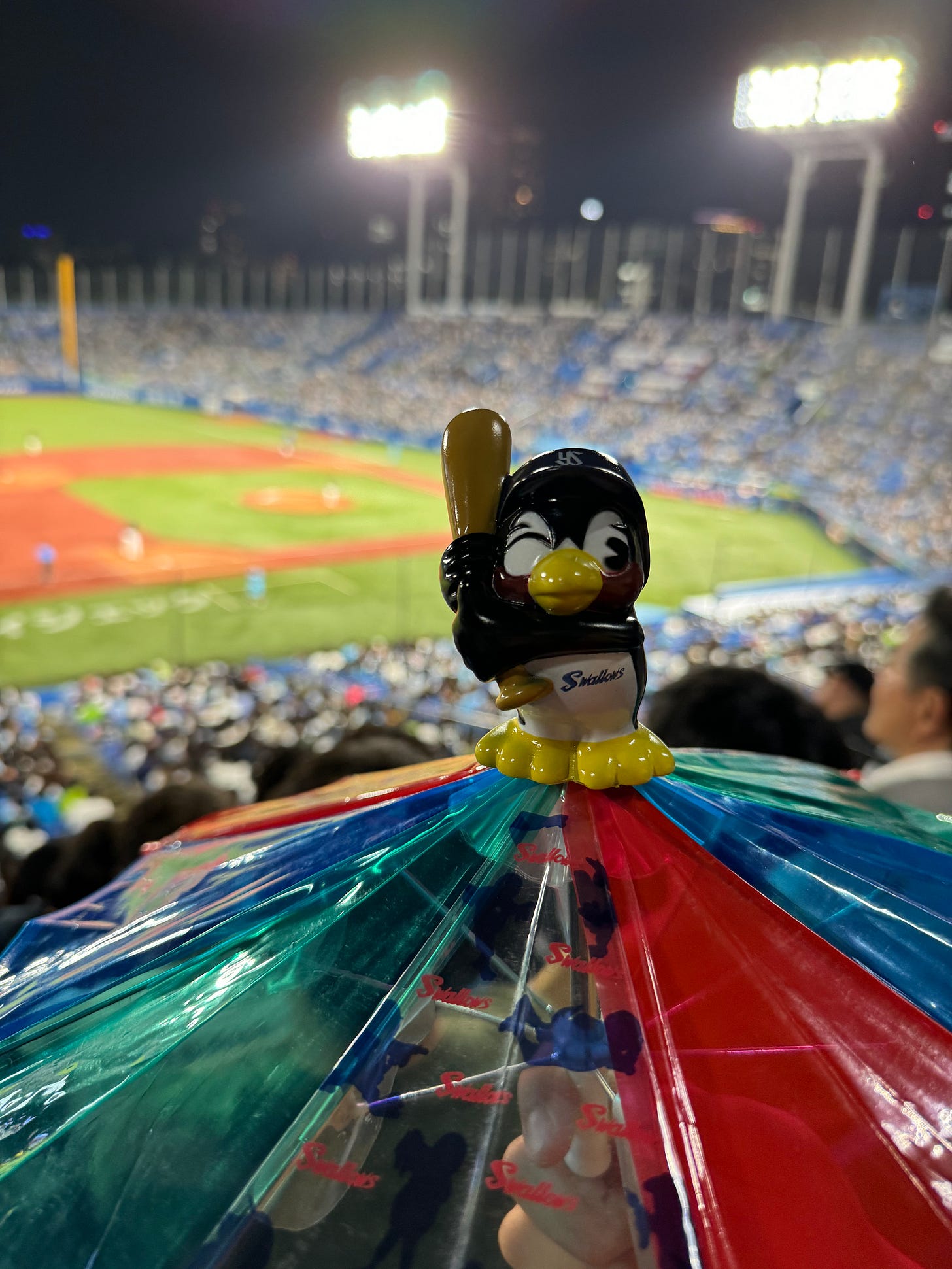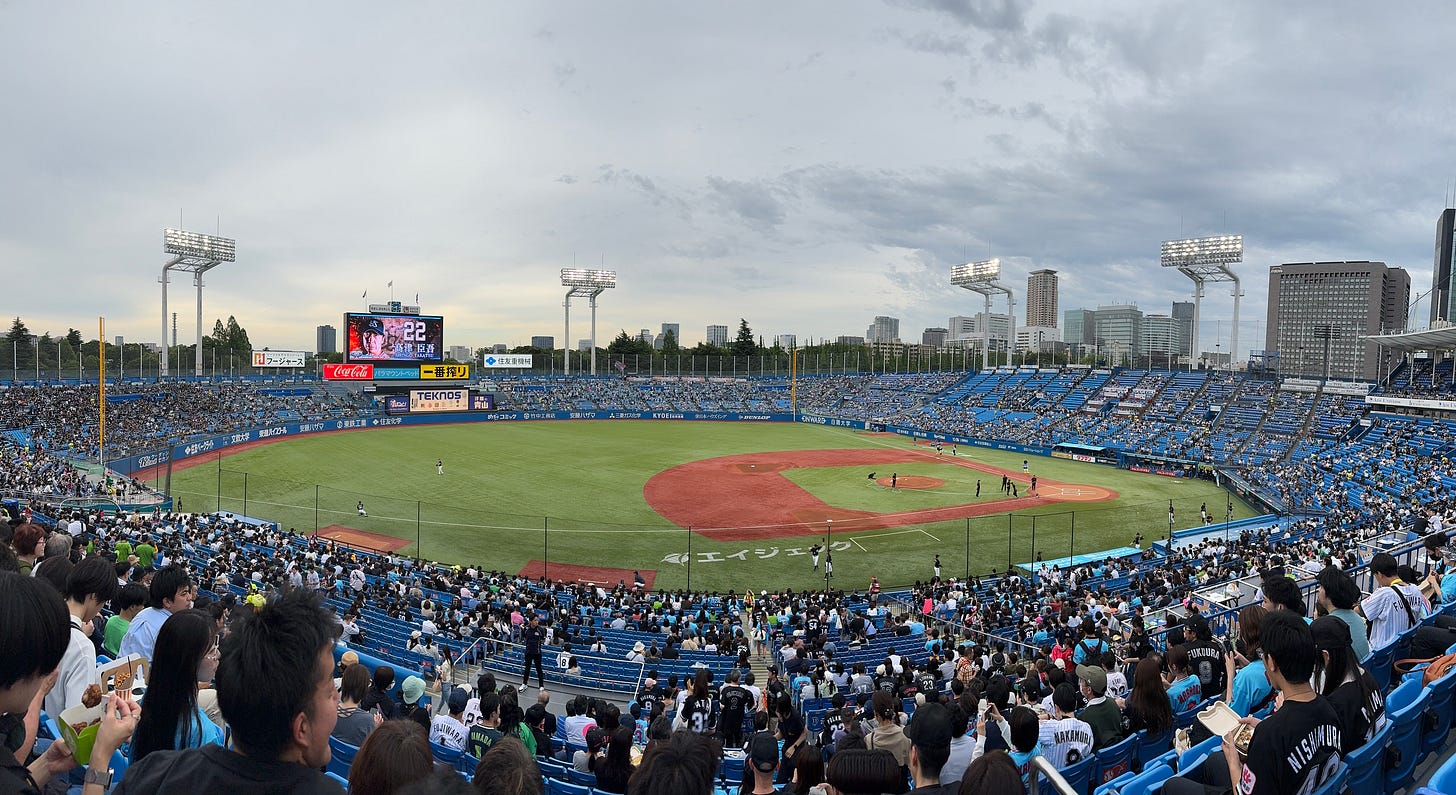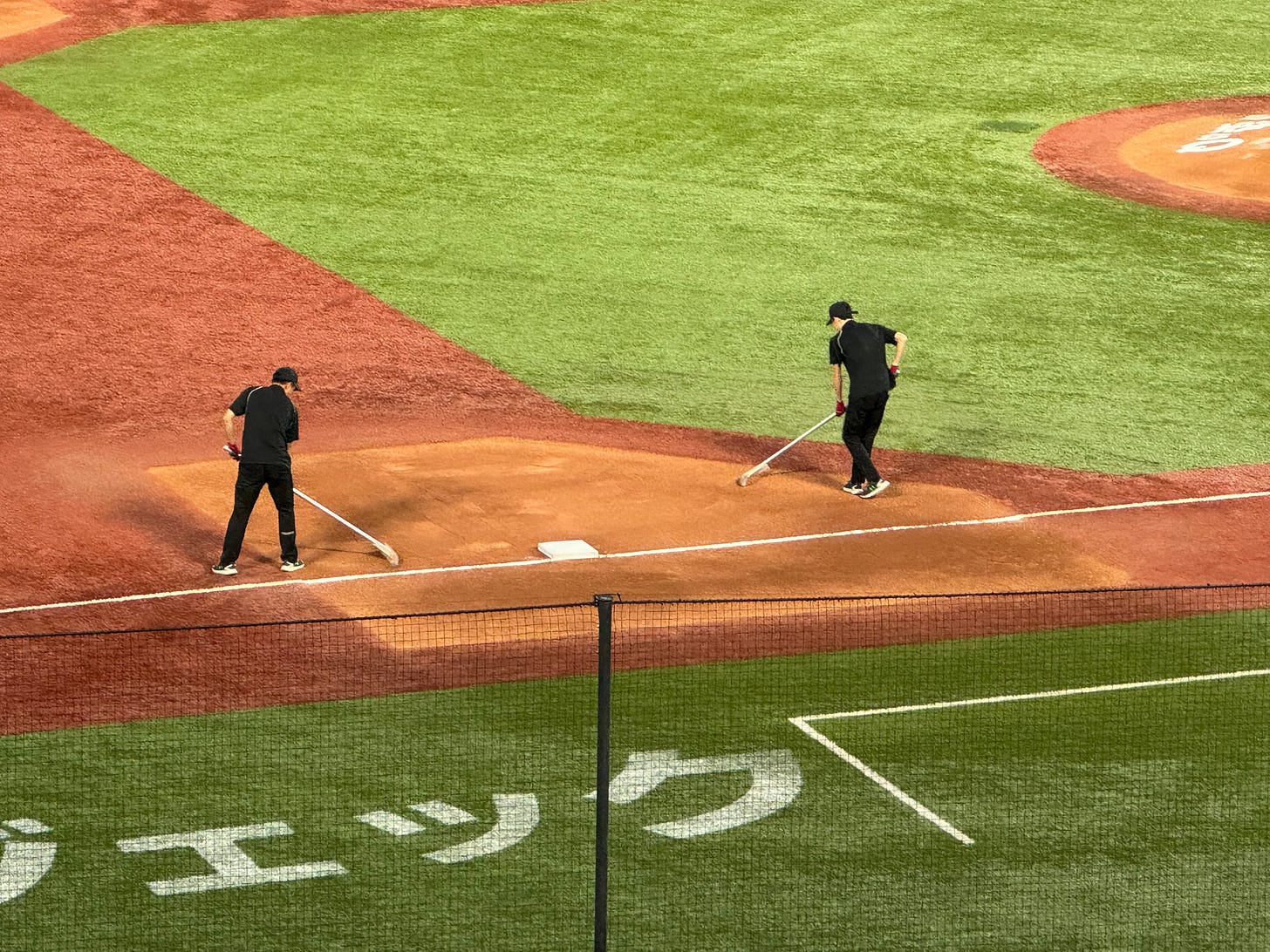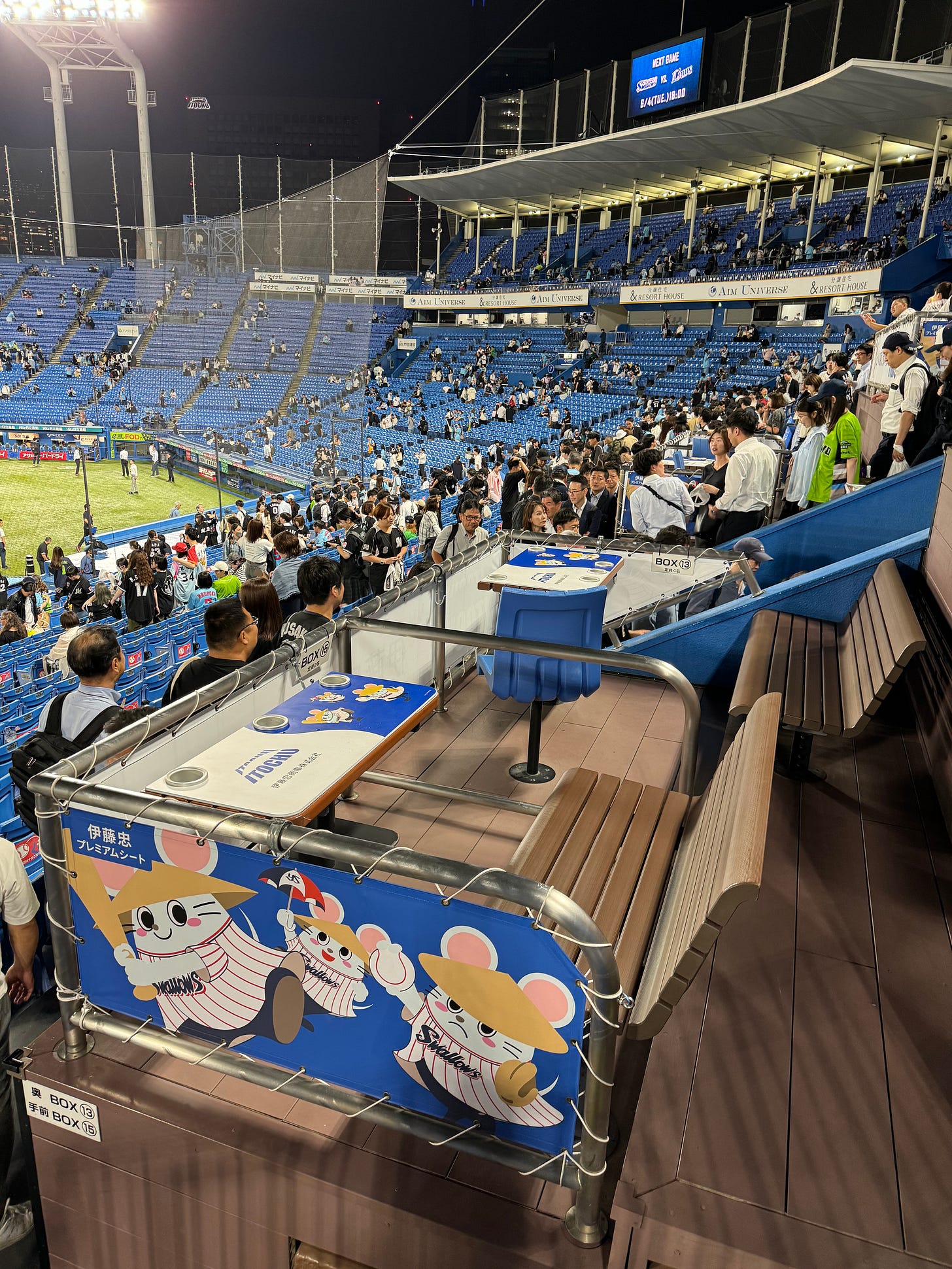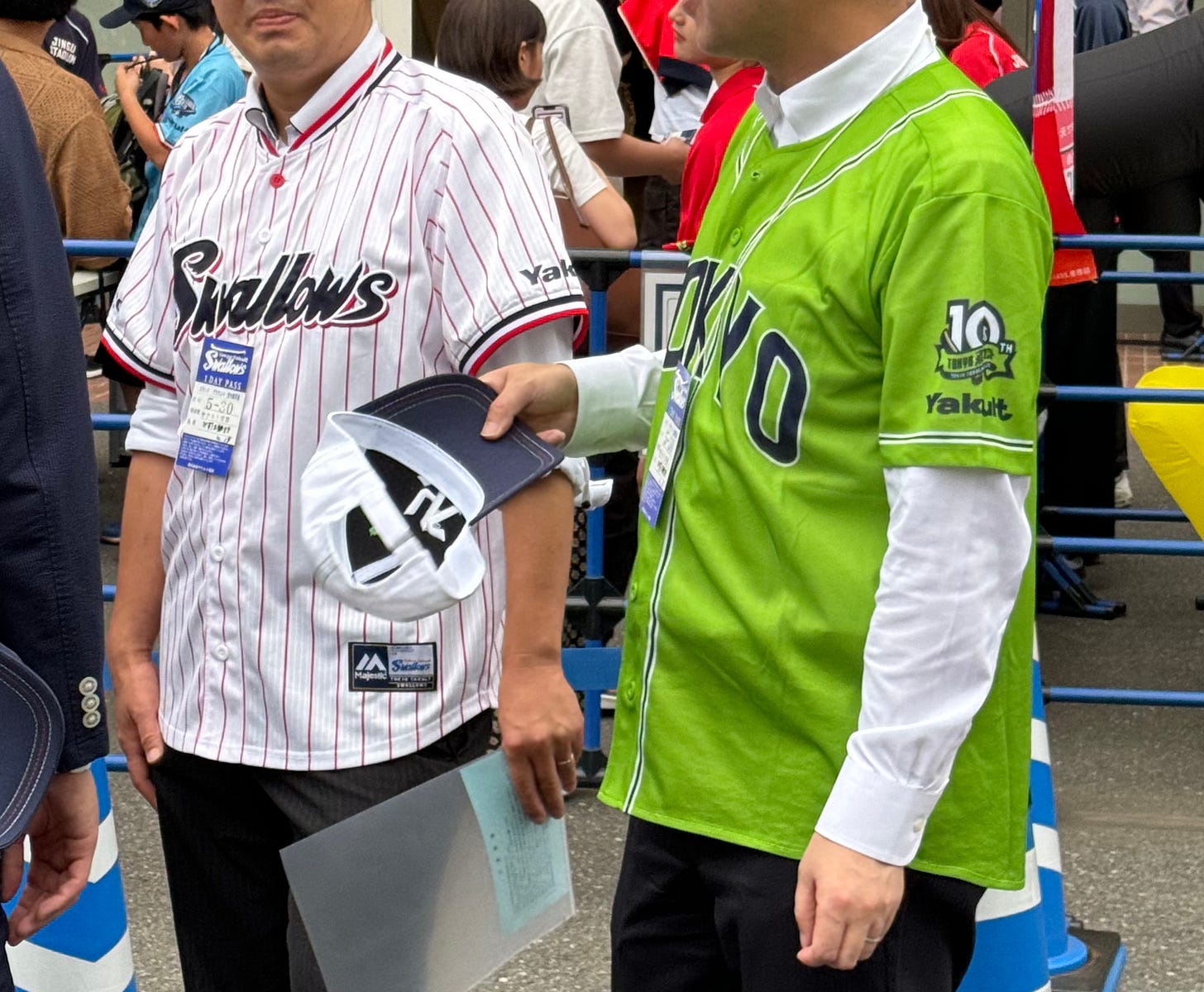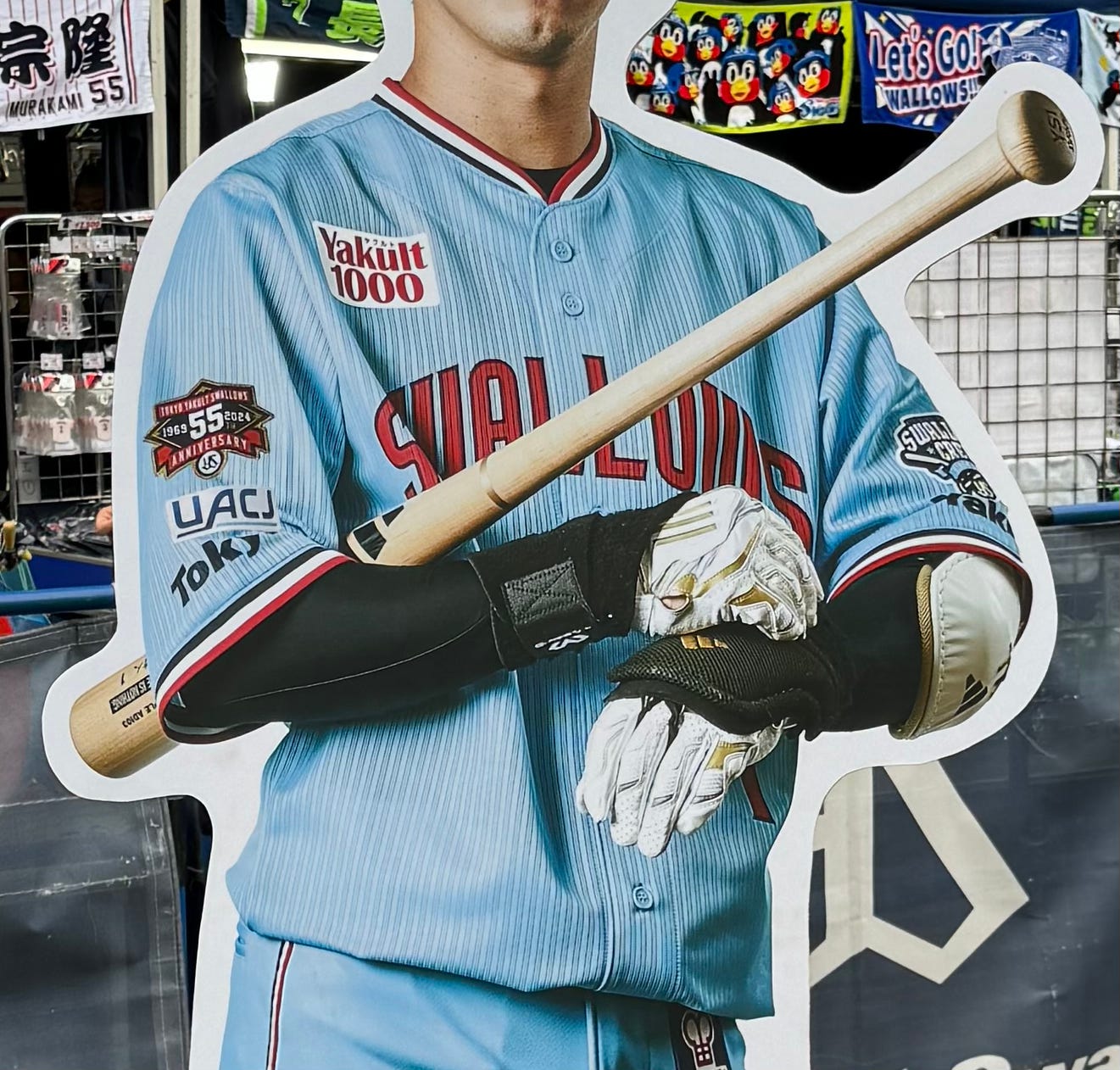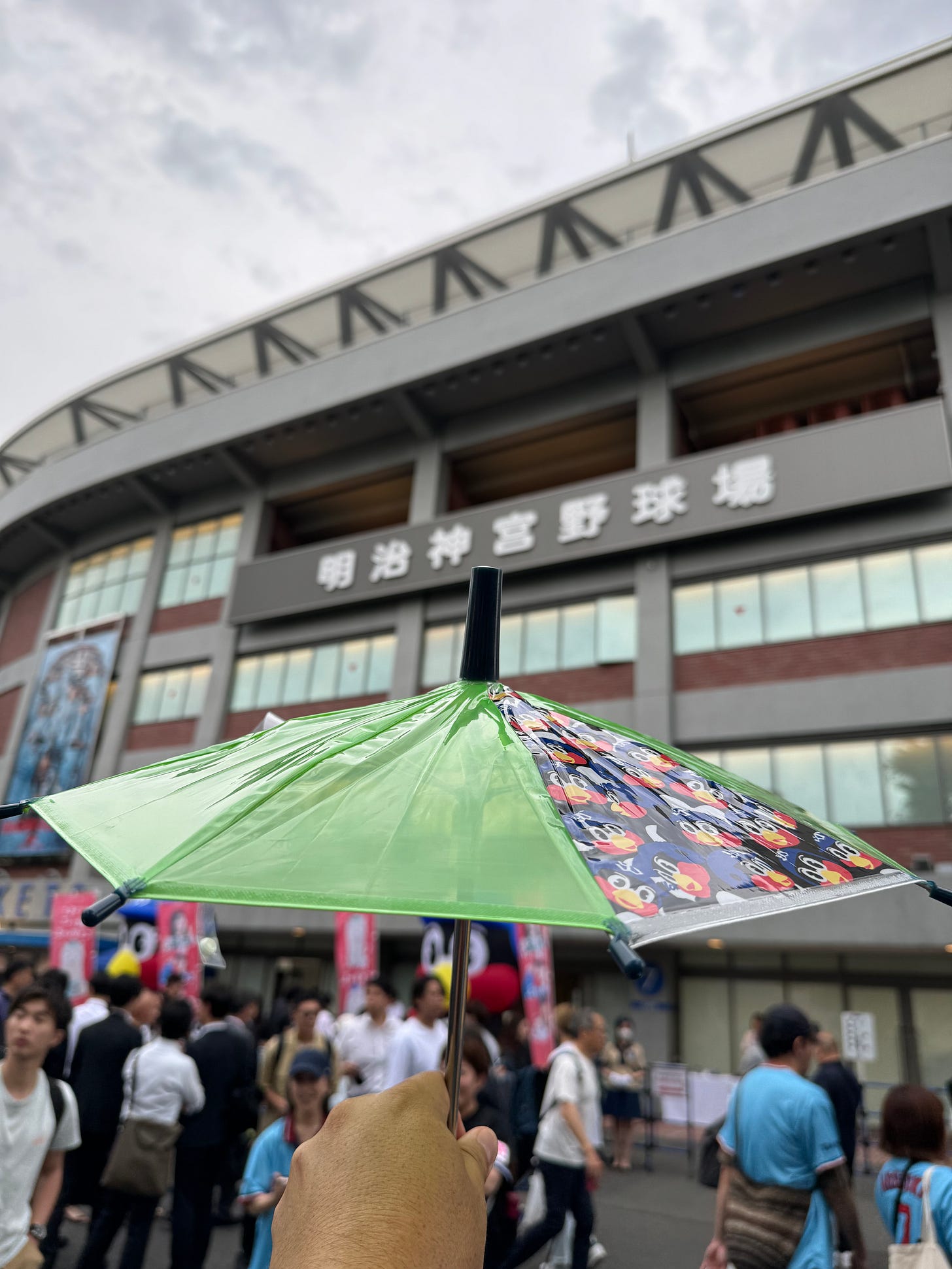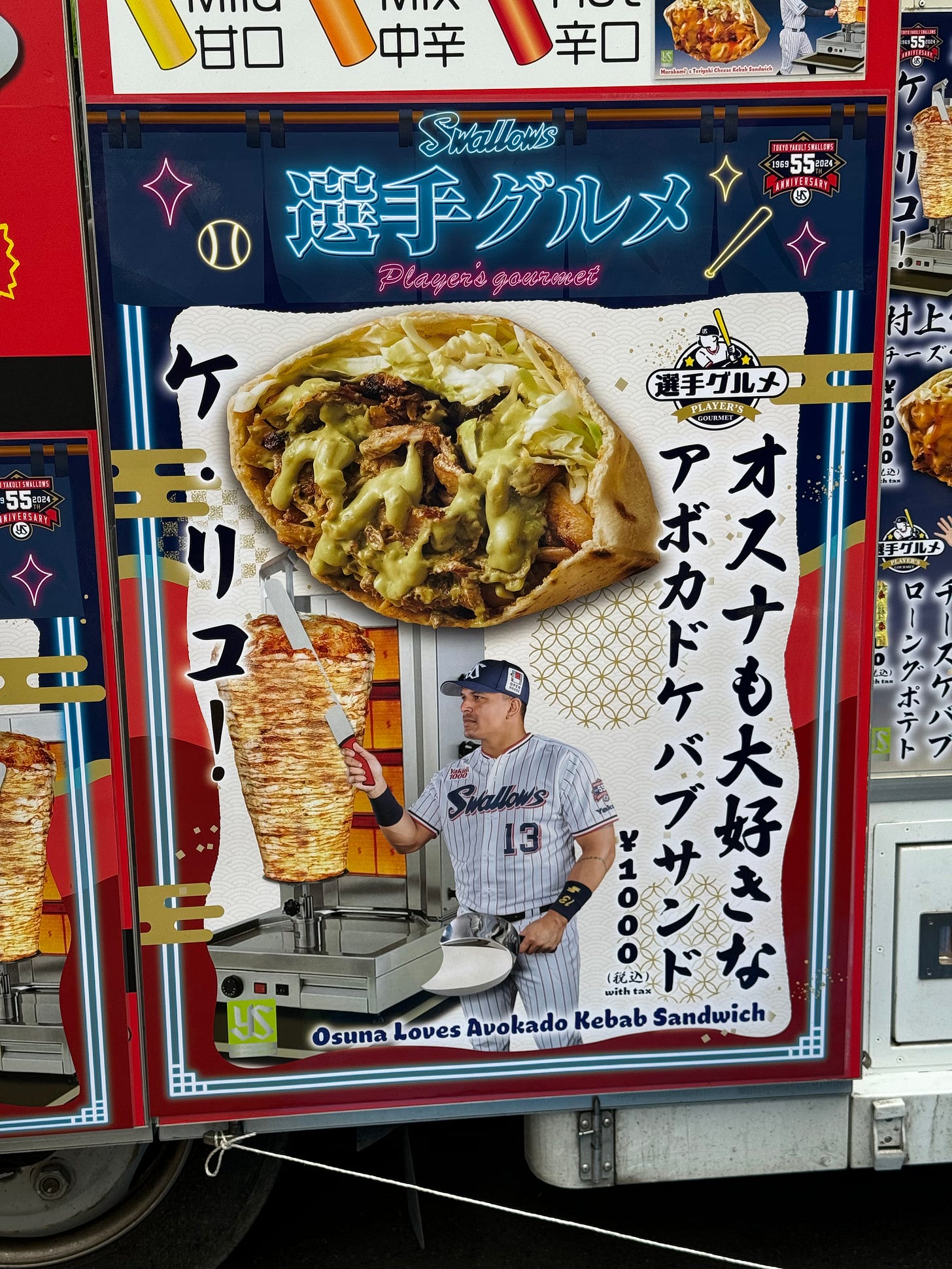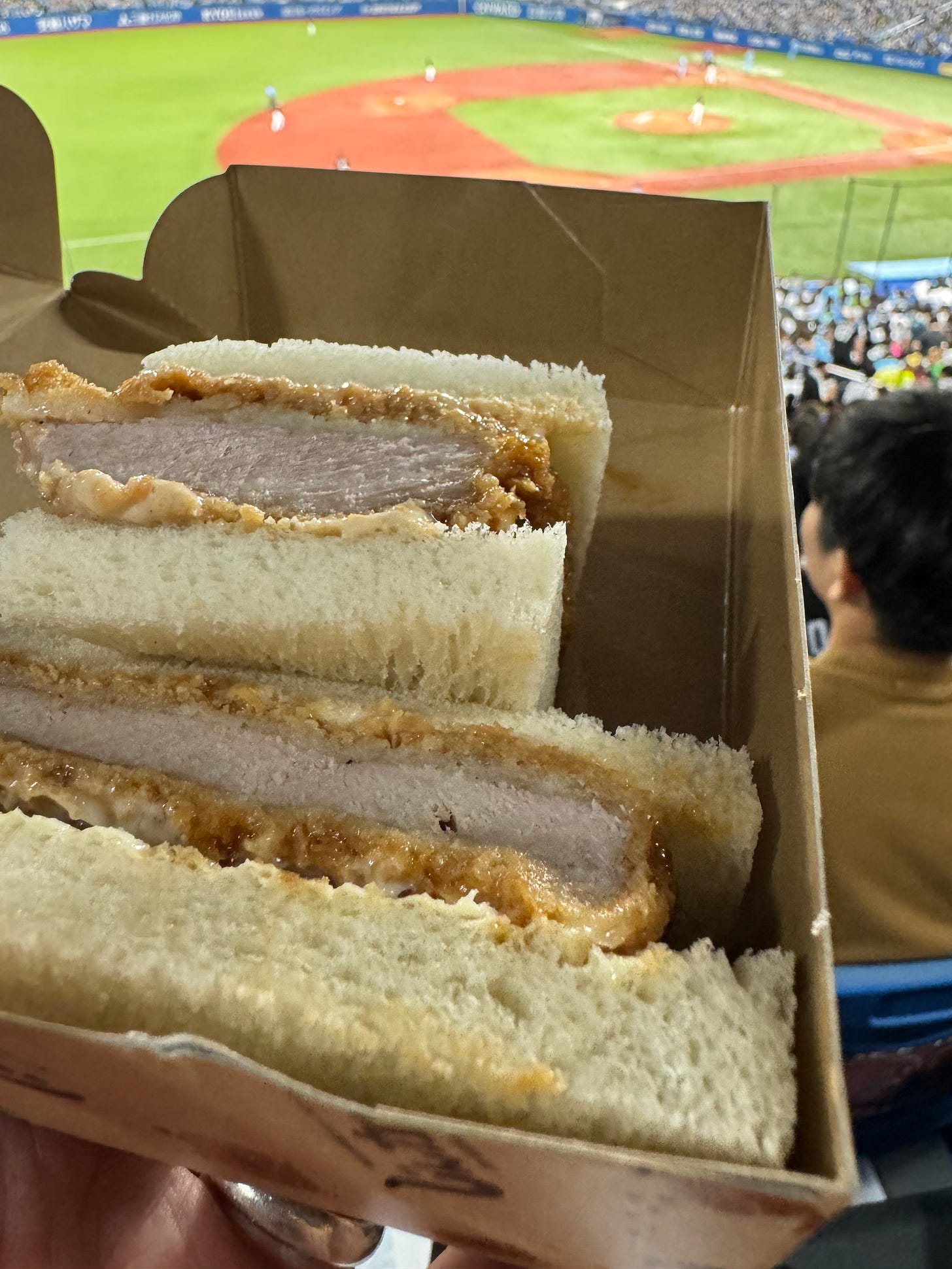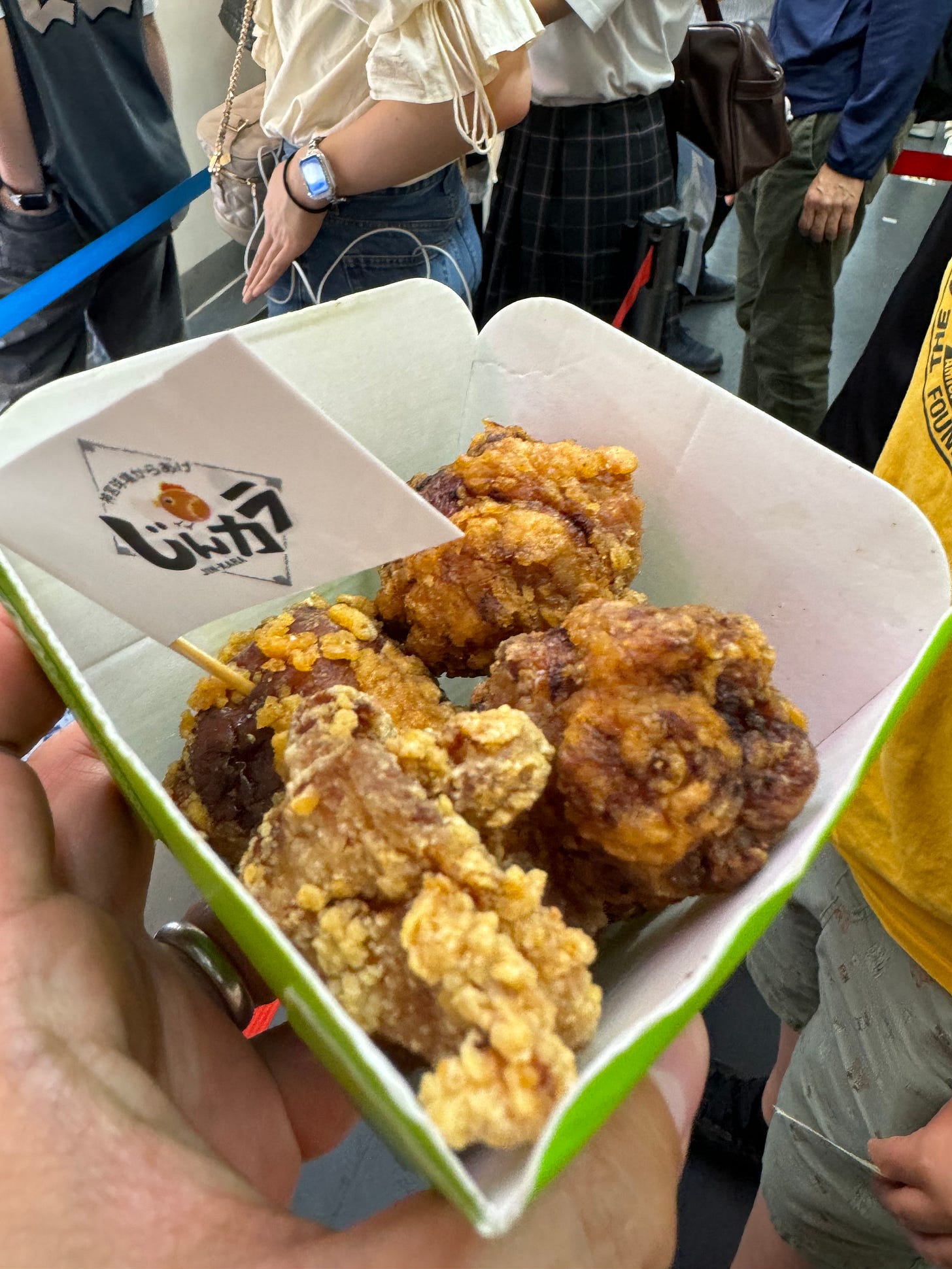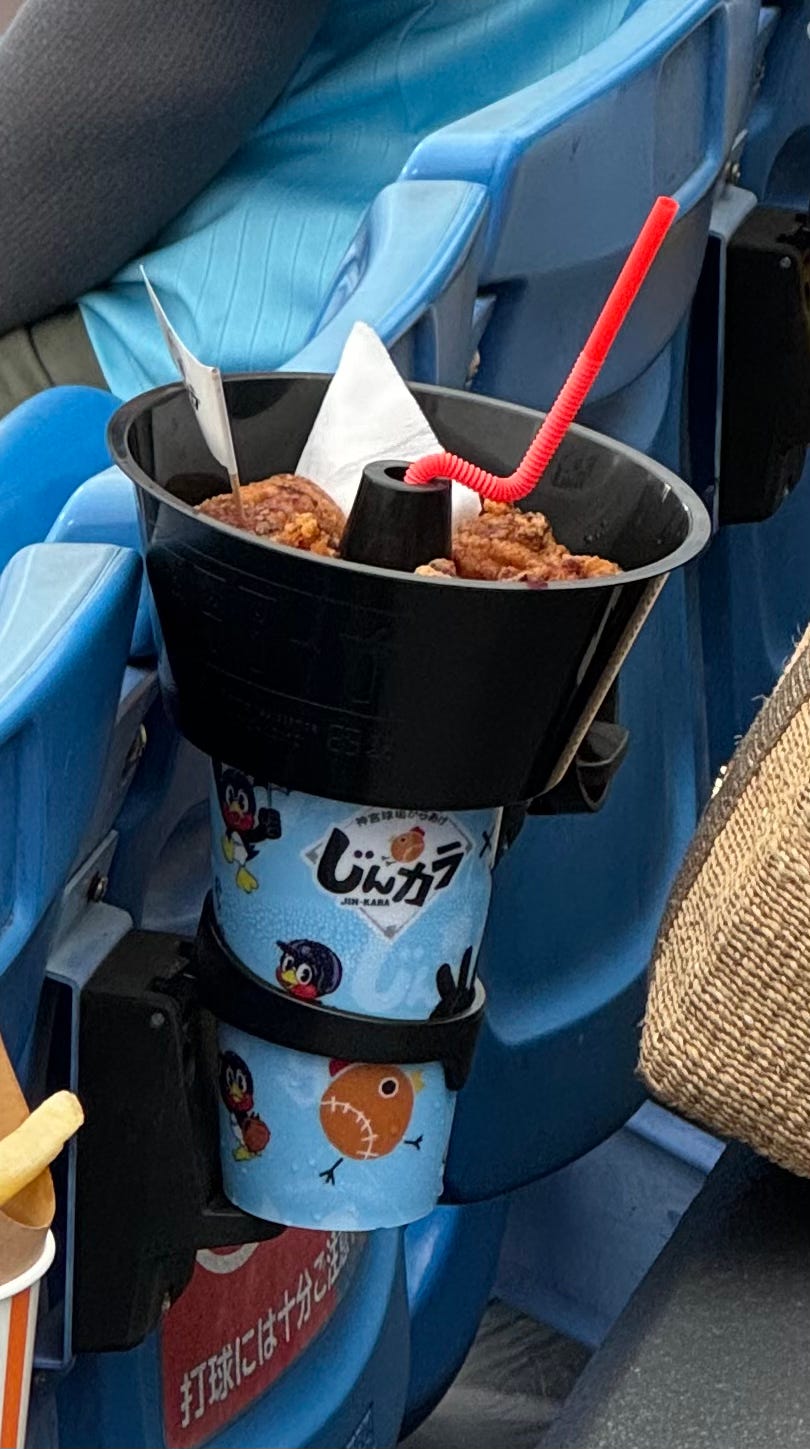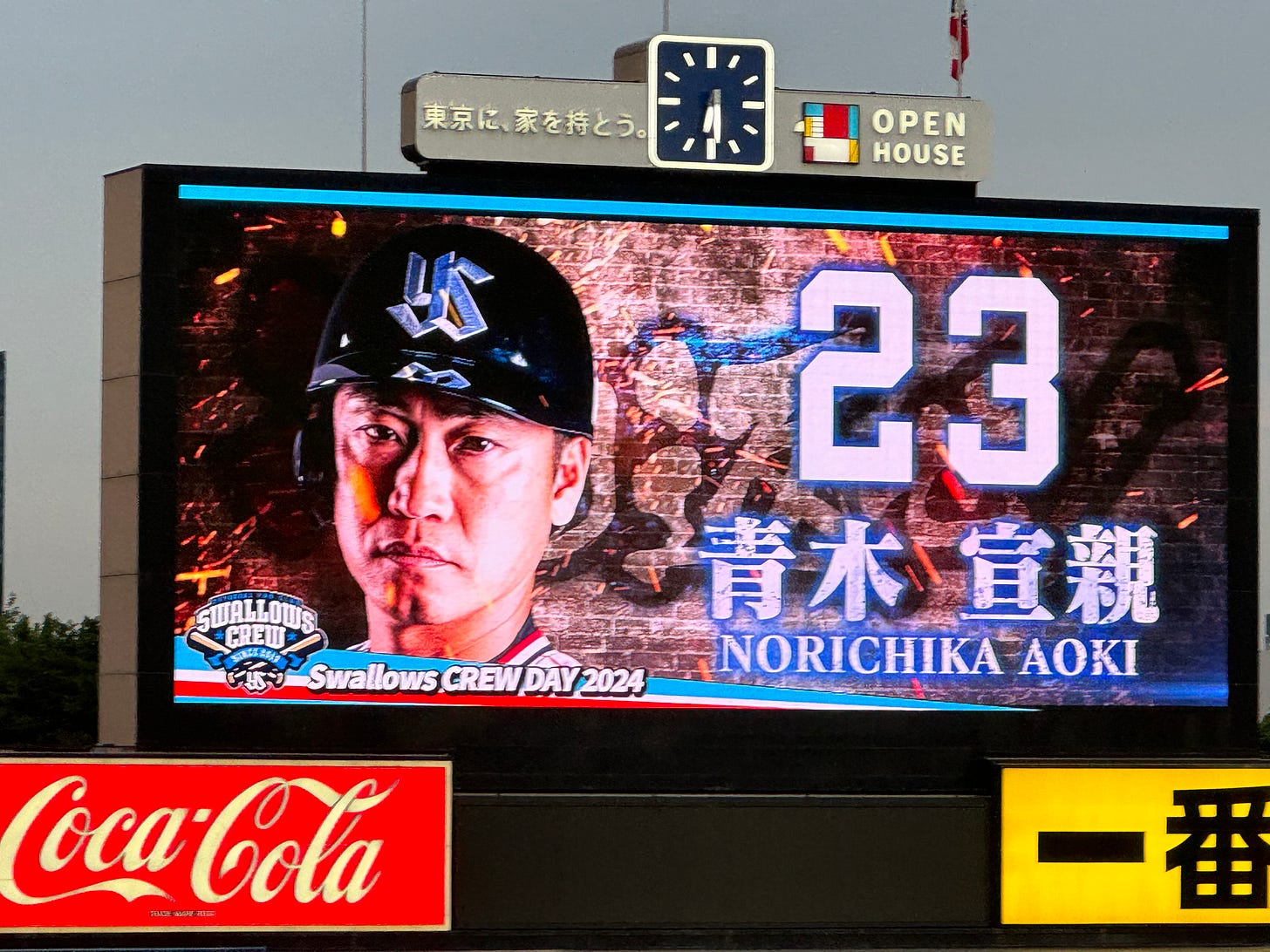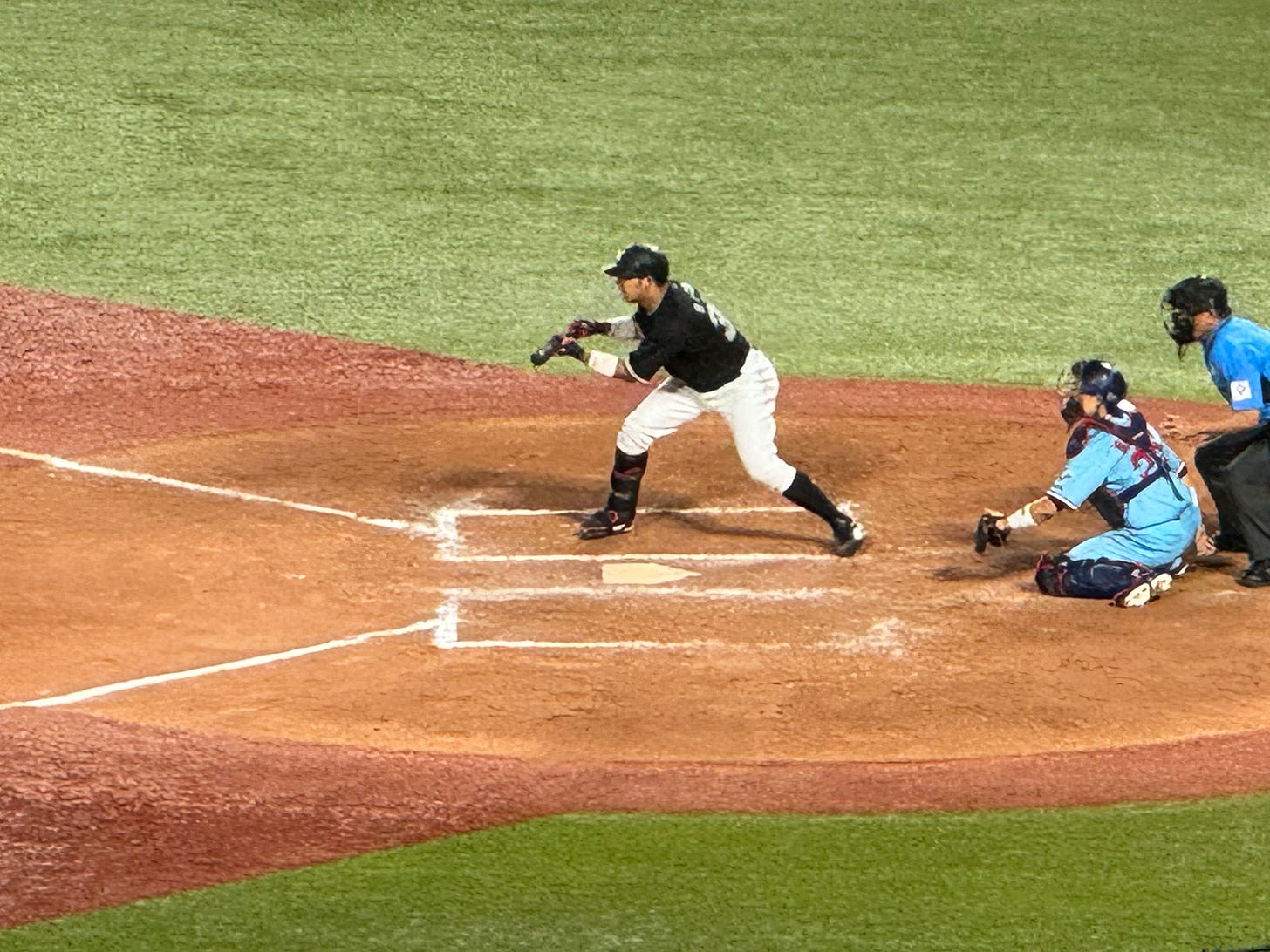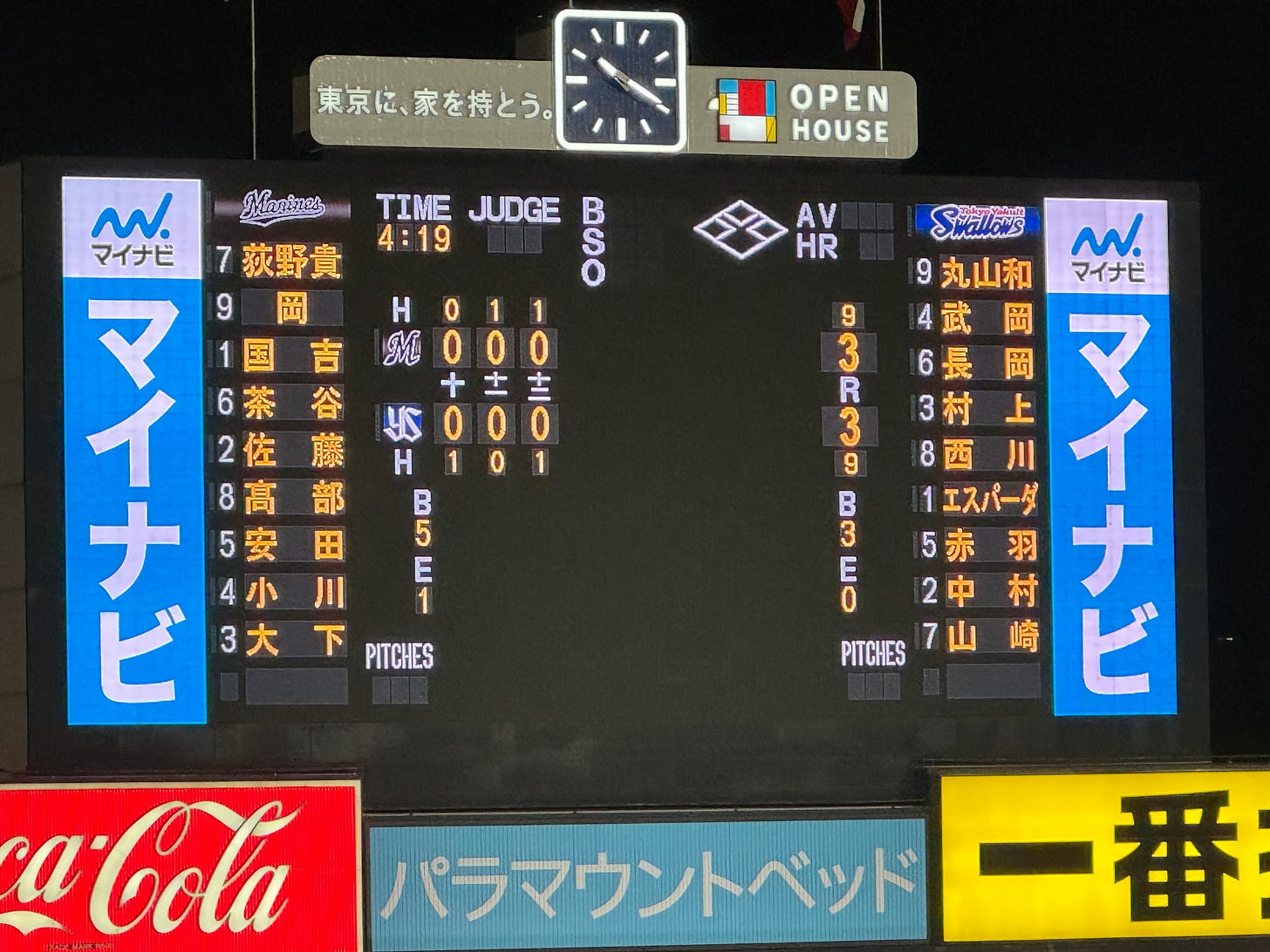Baseball in "The House That Ruth Once Played In"
♫♫ "Sharpen your focus and aim single-mindedly" ♫♫
Stop 4 on our baseball-tour-of-Japan was Meiji Jingu Baseball Stadium, in central Tokyo. Meiji Jingu Stadium sits amongst a collection of sports stadiums not far to the east of Harajuku (and, by definition, Meiji Shrine, aka Meiji Jingu), including the Japan National Stadium (rebuilt for the Tokyo “2020” Olympics) and Prince Chichibu Memorial Rubgy Ground, and is the home to the Yakult Swallows.
The Swallows are very much the Mets to the Yomiuri Giants’ Yankees, the Angels to their Dodgers, or the White Sox to their Cubs. Their fan support is significantly smaller, their national footprint less significant, and their history of success less rich. They’ve clearly taken some steps recently to become more prominent, including to foreign visitors for whom the Shibuya/Harajuku/Shinjuku area is commonly visited ground, including rebranding by adding “Tokyo” to their official name. But there’s definitely a secondary-feel to the team’s overall identity. That said, the swallow lends itself extremely well to a visual identity, which if anything is underutilized beyond a few basic points.
The stadium is the second oldest in Japanese baseball, having been built in 1926, only 2 years after Koshien and 12 after Wrigley (they love to highlight that Babe Ruth played here once back in the 30s). And it’s got a nice old feel to the exterior of the building, while its open-to-the-air bowl is again nice to see compared to the frequent use of domes. But there’s just a little something missing in terms of properly embracing that history in presenting a traditional feel. All of Fenway, Wrigley, and yes, Koshien, have been able to hold onto the character of their old parks, even as they’ve been upgraded and improved to keep up with the times. Perhaps even that renovation process itself, bringing with it a need to think intentfully and deeply about what aspects of the original stadium need to be preserved or replicated, has helped those parks honour their traditional elements in the way which inspired an entire generation of traditional-style parks across MLB in the 90’s and 00’s. Meiji Jingu feels like it’s missing that, and while the capacity exceeds Fenway’s at a hair under 40K, it feels a little more like an old minor-league park than a cherished treasure. Starkly different from Koshien that way.
Perhaps both contributing to that and coming from it, there are controversial plans in the works to tear down Meiji Jingu Stadium, and the next door rugby stadium, and to replace them both from scratch. You’d love to think they’d have thoroughly considered whether a wholesale renovation, as was done at Koshien, would be a viable alternative. But whether they have or not, it appears Meiji Jingu Stadium is headed for replacement, making it nice to have had a chance to visit while we could.
One of my biggest objections with the park is the use of artificial turf throughout. Putting artificial turf down on a park built in the 1920’s feels a bit like putting aluminum siding around the exterior walls of Meiji Jingu (the shrine) itself. We noted this in Yokohama as well, but I forgot to mention it, but not even the full infield “dirt” is dirt - most of it is actually just brown artificial turf, other than small patches around each base and the pitchers mound. Grass and dirt are both definitely more work to maintain, but nothing compares to real grass and dirt for baseball, and there’s a good reason why 25/30 MLB stadiums use grass. The 5 outliers are all domes, and while you can understand using turf in fixed domes in Japan, the open air nature and history of Meiji Jingu Baseball Stadium make this particularly egregious.
Consistent with the age of the stadium and the lack of renovations, there are no suites at all built into the stadium. The closest were these sections of “premium seating”, providing some of a box’s amenities within the stands.
The game itself was between the team with the white/red/navy colour palette and the team with the green/navy colour palette. Nope, wait… the other team must be the one in baby-blue/red. No… hang on a minute, let me check my notes.
Yes, actually, as you can see from the pictures, all 3 of those colour palettes belong to the Swallows. Overall, it’s kind of hard to put your finger on what the Swallow’s primary colours are. While there are some MLB teams with a similar dynamic (I’m looking at you, Texas), this was definitely confusing, and is the sort of thing that, while small, can undermine a team’s attempts to build a solid and consistent visual identity. As TTTTTTT pointed out, the MLB City Connect program has resulted in each MLB team having a uniform in a completely unrelated colour palette, but that still feels like a very distinct, league-wide, and intentionally off-the-wall approach.
THE signature item of the Yakult Swallows is the umbrellas. These miniature umbrellas are the main cheering element, and are waved around anytime they score, and are the cornerstone of the 7th inning team celebration. Of course, we bought a couple to join along.
They’re also theoretically helpful when you get a bit of rain, as we did mid-game. Ok… not actually helpful - they’re big enough to cover your head, but only if you want all that rain to then hit your shoulders. But it’s a nice thought.
And, more about these guys later, but mad props to some of the Lotte fans, who did what I believe was some excellent trolling by bringing along their own team-colour umbrellas to wave as well.
Here’s that Seventh Inning “Umbrella Dance”. As with other stadiums across Japanese Baseball, it’s not really a “7th Inning Stretch”, given that you don’t stand up.
The Swallows mascot is named Tsubakurou, and wears uniform number 2896, a play on words of “tsu/two” - “ba/hachi” - “ku/kyu” - “rou/roku”. He’s great, and got a very distinct look. He’s also got some great supporting story writers, I assume in the team’s social media team, as he’s apparently on a rolling one-year contract with the team, threatening to go elsewhere each summer - a recent contract was only reached when his agent, the koala mascot of the Chunichi Dragons, negotiated an all-you-can-drink supply of Yakult for him. Here he is rocking out to the pre-game music.
That said, we didn’t see this guy, who’s apparently a new Lotte mascot. Definitely a shame. I’ve thus yet to see an Anglerfish’s skeleton jump out of its mouth in oversize mascot style in real life. #LifeGoals.
A lot of the food items were situated in the ground just outside of the stadium, a reflection of the limited concourse space. They had some really great player promotion built in.
We settled for a bit of mentaiko long-potato (unpictured), some katsusando, and a bit of karaage.
We missed out, for the second time, on this amazing invention solving the age old problem of how to hold your drink and food at the same time.
In a blast from the past moment, one of the Swallows players was Nori Aoki, who had a 6 year career in the Majors, including playing for the SF Giants in 2015 (one year after they beat him and the Royals in the World Series). True to form, as a 42-year old who played for the Swallows both before and then again after his MLB career, the fan section played the theme music from Back to the Future as he came to the plate.
For the second game in a row, though, the road fans outdid the home fans in terms of enthusiasm and support. Hard to say whether this is a reflection of the teams’ relative fan bases (it seems maybe yes?) but the Chiba Lotte Marines fans were definitely into it.
Again, as in Yokohama, the stadium played the road team’s cheering song for them at the top of the 7th. Very impressive sportsmanship.
While there was a decent screen in the outfield, and a tiny one high above home plate, replays were in very short supply. After each plate appearance, they would show the moment of bat-impact (if any) for the last pitch, to help you see the batter’s swing. But nothing else was ever broadcast across the park. Great defensive plays, close calls, baserunning blunders - all of it was witness live or never see again. It’s a shame, and again another reinforcement of the fact that offensive prowess seems to be valued above all else. Even there, the outcome of the swing was never shown, with replays frozen at the moment of bat contact. Odd…
What we did get to see for the first time was an unobstructed view of the bullpen, placed as they were just outside the foul lines. That meant a good view of pitchers warming up (nice to see from a strategic understanding standpoint), but also a remarkable experience just before pitchers came in. As you can see from the video below, when it became clear a pitcher was about to come into the game, the rest of the bullpen would gather around them and watch them make their final pitch. Then, the pitcher would be ceremonially handed a cup of drink, given a collective “attaboy”, and seen into the game. It’s very wholesome, as an affirmation and encouragement, and more than a bit amusing to see happen each time (and there were a lot of pitchers we got to see come into this particular game).
The art of sacrifice bunting, meanwhile, is alive and well in Japanese baseball. This is again true to the established stereotype, but after watching a lot of North American baseball, in which sacrifice bunting is all but gone from the game. But here, it’s like a flash back to the 80’s, where the bunt is practically automatic under a wide range of situations. [Ed Note: Great article here about some of this, with highlight quote “Bunts are like dill”, though there are loads of articles about the death of bunting in MLB and its continued existence in Japan]
In the end, the game wound up being the first we’ve seen in which the home team didn’t lose. That said, it also was yet another game in which the home team didn’t win either. That’s because after reaching the end of the 12th with the game still a tie, Japanese baseball rules declare the game over, and officially a tie (even if Google’s listings of NPB standings can’t quite get their heads around that). Even worse for the home fans, the Swallows entered the 9th with a 1-run lead, only to give back that run in the top of the 9th and settle for the tie. EVEN worse, it was the second night in a row when they were beating Lotte 3-2 going into the 9th, only to settle for a 3-3 tie. Ouch.
Still, a step in the right direction. Maybe we’ll FINALLY see a home win when we cheer on the Giants at the Tokyo Dome this week.
In summary, it was nice to see a game at Meiji Jingu Baseball Stadium, especially if it does get torn down in the years ahead. It’s a piece of history, and it’d be nice to see Tokyo’s second team do better overall. That said, it does feel like this park is missing a little something. There was none of the deep tradition and classic feel of Koshien, despite the opportunity given the park’s history. Whether it’s a top-to-bottom upgrade of the stadium in place (which would be great) or a complete replacement, here’s hoping for good days ahead for the Swallows.





